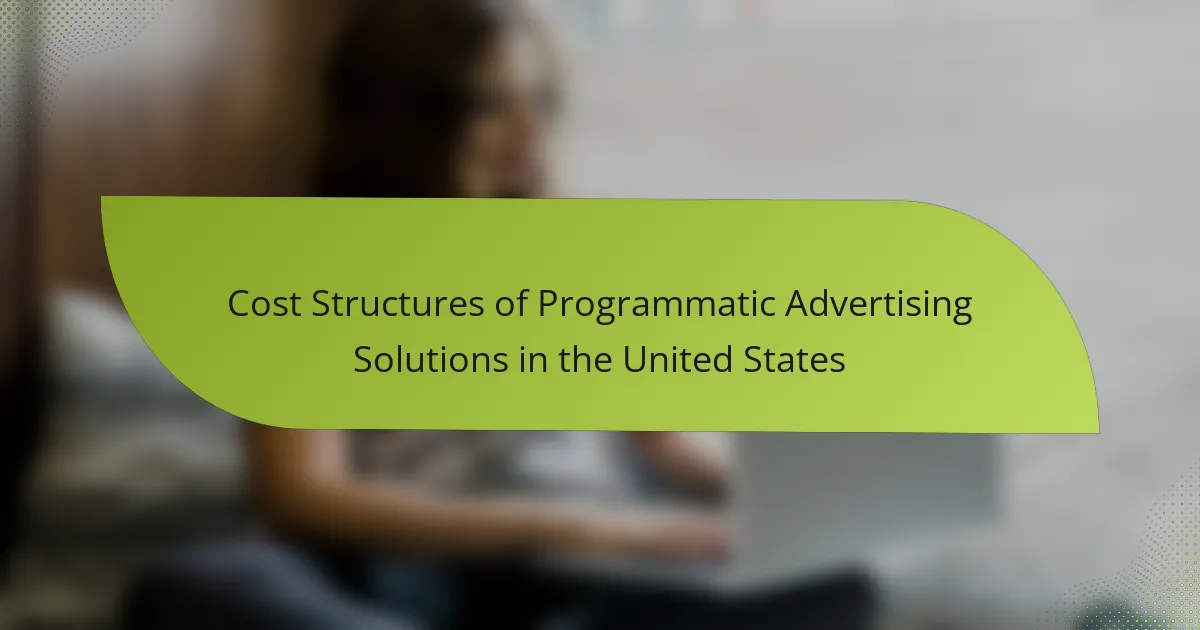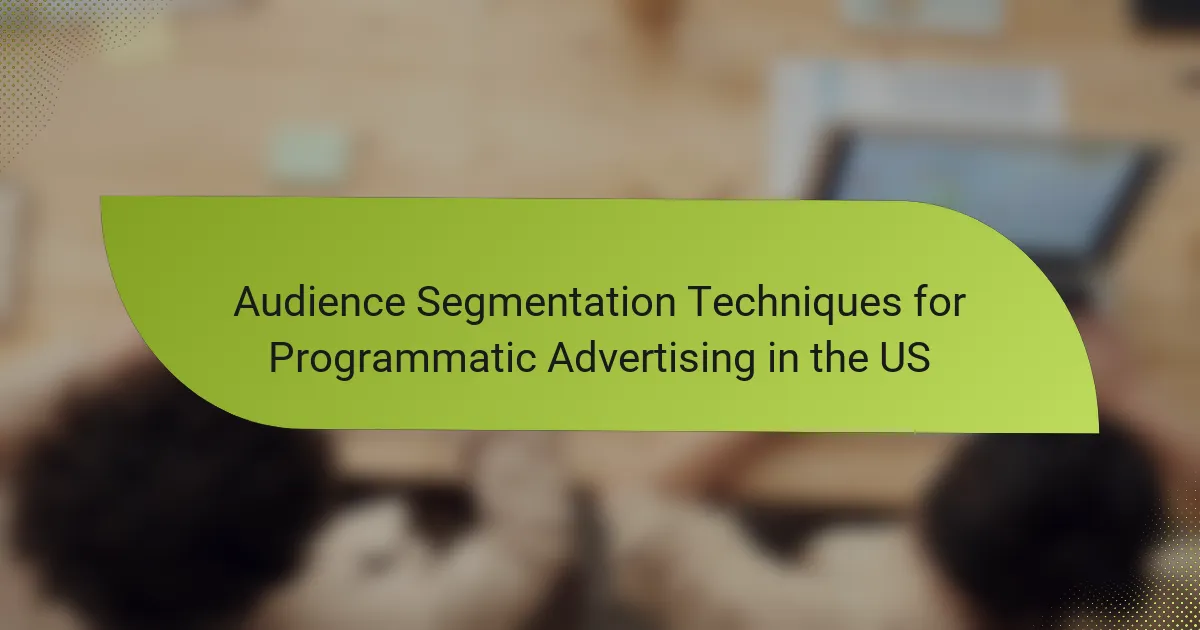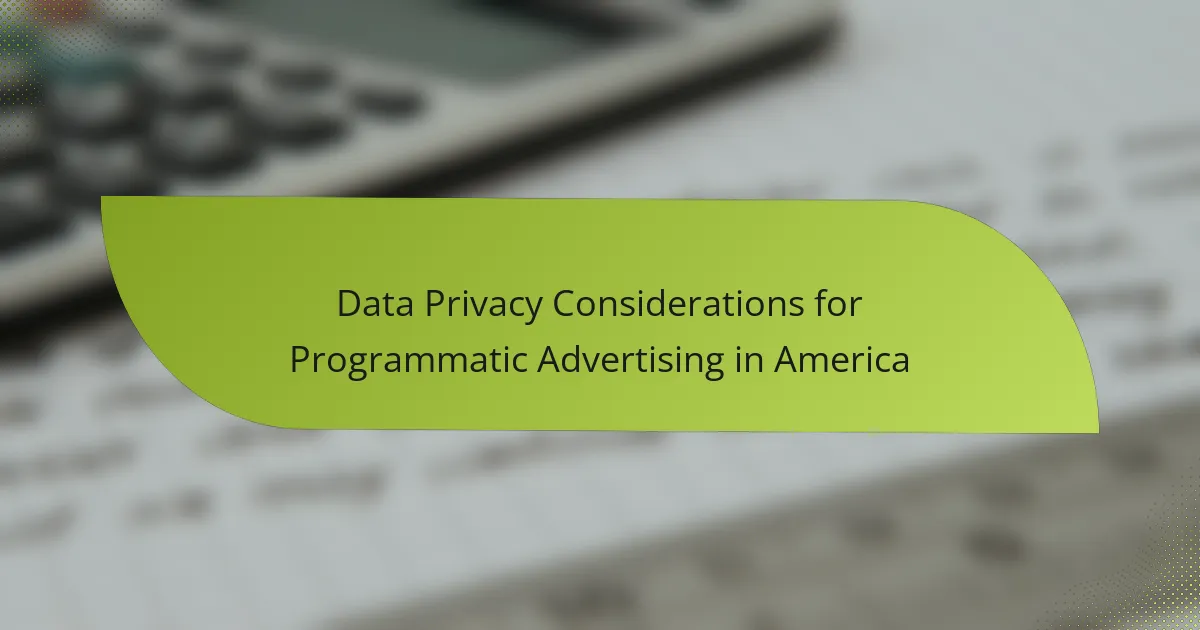The cost structures of programmatic advertising solutions in the United States are primarily defined by three models: Cost per Mille (CPM), Cost per Click (CPC), and Cost per Acquisition (CPA). These models play a crucial role in helping advertisers optimize their budgets and achieve their campaign goals, as costs can vary significantly based on factors such as audience targeting, ad formats, and competition.
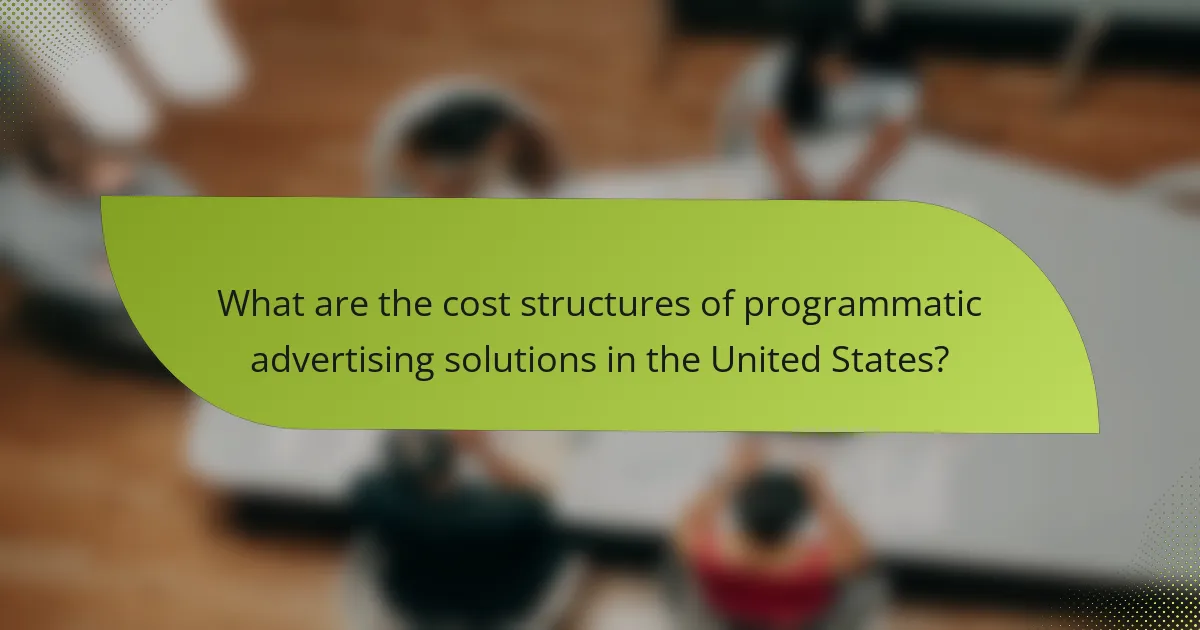
What are the cost structures of programmatic advertising solutions in the United States?
The cost structures of programmatic advertising solutions in the United States primarily revolve around three key models: Cost per Mille (CPM), Cost per Click (CPC), and Cost per Acquisition (CPA). Understanding these models is crucial for advertisers to optimize their budgets and achieve desired outcomes.
Cost per mille (CPM) model
The Cost per Mille (CPM) model charges advertisers based on the number of impressions, specifically every thousand views of an ad. This model is ideal for brand awareness campaigns where the goal is to reach a large audience rather than drive immediate actions.
CPM rates can vary significantly based on factors such as the ad placement, audience targeting, and the time of year. Typically, CPM rates in the U.S. can range from a few dollars to over $30, depending on the platform and competition for ad space.
When using the CPM model, advertisers should focus on selecting high-quality inventory and optimizing their targeting to ensure their ads reach the intended audience effectively.
Cost per click (CPC) model
The Cost per Click (CPC) model charges advertisers only when a user clicks on their ad. This model is beneficial for campaigns aimed at driving traffic to a website or generating leads, as it directly ties costs to user engagement.
CPC rates can fluctuate based on competition, keyword selection, and ad quality. In the U.S., CPC can range from under $1 for less competitive keywords to over $10 for highly sought-after terms. Advertisers should regularly monitor their CPC rates to ensure they remain within budget while maximizing click-through rates.
To optimize CPC campaigns, focus on creating compelling ad copy and using targeted keywords that resonate with your audience, as this can improve both click rates and overall campaign performance.
Cost per acquisition (CPA) model
The Cost per Acquisition (CPA) model charges advertisers based on the actual acquisition of a customer, such as a sale or sign-up. This model is particularly effective for performance-driven campaigns where the goal is to generate measurable results.
CPA rates can vary widely depending on the industry and the specific action being measured. In the U.S., average CPA can range from $10 to several hundred dollars, depending on the product or service being offered. Advertisers should analyze their customer lifetime value to determine a profitable CPA target.
To succeed with CPA campaigns, ensure that your landing pages are optimized for conversions and that you are using effective retargeting strategies to engage users who have shown interest in your offerings.
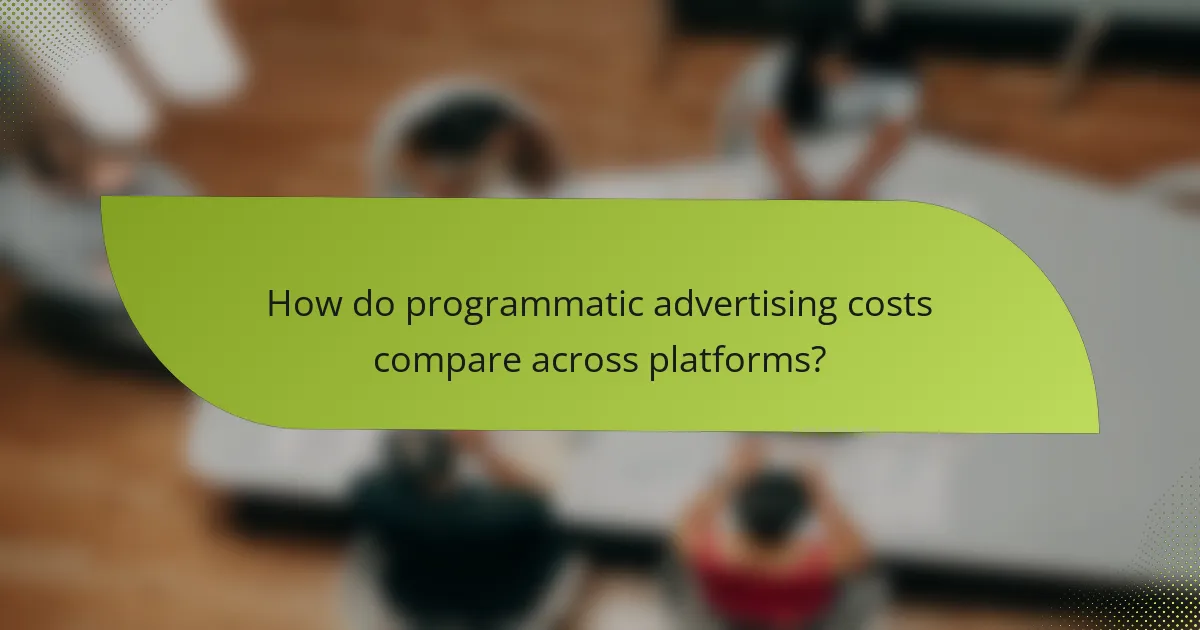
How do programmatic advertising costs compare across platforms?
Programmatic advertising costs vary significantly across platforms, influenced by factors such as audience targeting, ad formats, and competition. Understanding these differences can help advertisers allocate budgets more effectively and maximize return on investment.
Google Display Network pricing
The Google Display Network (GDN) operates on a cost-per-thousand impressions (CPM) model, with prices typically ranging from $1 to $10, depending on targeting options and competition. Advertisers can also opt for cost-per-click (CPC) pricing, which usually falls between $0.10 and $2.00 per click.
When using GDN, consider the quality of your ad creatives and the relevance of your targeting. Higher quality ads and precise targeting can lead to better performance and lower costs. Regularly monitoring campaign metrics will help optimize spending.
Facebook Ads pricing
Facebook Ads pricing is primarily based on a bidding system, with average costs ranging from $0.50 to $3.00 per click, depending on the audience and ad placement. CPM rates can vary widely, often between $5 and $15, influenced by factors such as seasonality and competition.
To manage costs effectively on Facebook, set clear campaign objectives and utilize A/B testing to refine your ads. Keep an eye on your ad relevance score, as higher scores can lead to lower costs and better placements.
Amazon Advertising pricing
Amazon Advertising typically uses a cost-per-click (CPC) model, with average costs ranging from $0.20 to $2.00 per click, depending on the product category and competition. Sponsored Products and Sponsored Brands are popular options, with varying costs based on keyword competitiveness.
To optimize your Amazon ad spend, focus on high-converting keywords and regularly adjust bids based on performance. Consider using automatic targeting initially to gather data, then refine your strategy with manual targeting for better results.

What factors influence programmatic advertising costs?
Programmatic advertising costs are influenced by several key factors, including target audience demographics, ad placement quality, and seasonal demand fluctuations. Understanding these elements can help advertisers optimize their budgets and achieve better campaign results.
Target audience demographics
The demographics of your target audience play a crucial role in determining programmatic advertising costs. Advertisers often pay more to reach specific segments, such as high-income individuals or niche markets, due to their higher value. For instance, targeting millennials may incur higher costs compared to broader demographics due to their purchasing power and engagement levels.
Additionally, the geographic location of your audience can impact costs. Urban areas typically have higher CPM (cost per thousand impressions) rates than rural regions, reflecting the competitive nature of ad placements in densely populated markets.
Ad placement quality
The quality of ad placements significantly affects programmatic advertising costs. Premium placements, such as those on high-traffic websites or within popular apps, generally command higher prices due to their visibility and engagement potential. Advertisers should assess the reputation and performance metrics of the platforms they choose to ensure they are getting value for their investment.
Moreover, utilizing advanced targeting options, like contextual or behavioral targeting, can enhance ad placement effectiveness but may also increase costs. Balancing quality with budget constraints is essential for maximizing return on investment.
Seasonal demand fluctuations
Seasonal demand fluctuations can lead to significant variations in programmatic advertising costs. During peak shopping seasons, such as holidays or major events, competition for ad space intensifies, often resulting in higher CPM rates. Advertisers should plan campaigns around these periods to capitalize on increased consumer spending while being prepared for elevated costs.
Conversely, off-peak seasons may present opportunities for lower costs and less competition. Monitoring industry trends and adjusting ad strategies accordingly can help advertisers optimize their spending throughout the year.

What are the benefits of programmatic advertising in the US?
Programmatic advertising in the US offers efficiency, precision, and scalability, allowing advertisers to automate the buying process and target specific audiences effectively. This approach enhances return on investment by optimizing ad placements in real-time based on data insights.
Real-time bidding advantages
Real-time bidding (RTB) allows advertisers to bid for ad space in milliseconds, ensuring that the most relevant ads reach the right audience at the right time. This competitive environment can lead to lower costs per impression compared to traditional methods.
With RTB, advertisers can set specific parameters for their campaigns, such as budget limits and audience demographics. This flexibility helps maximize ad spend efficiency and can lead to higher engagement rates.
Data-driven targeting capabilities
Programmatic advertising leverages vast amounts of data to enable precise targeting based on user behavior, preferences, and demographics. This data-driven approach allows advertisers to reach niche audiences effectively, increasing the likelihood of conversion.
Advertisers can utilize various data sources, including first-party data from their own platforms and third-party data from external providers. By analyzing this information, they can create tailored campaigns that resonate with specific segments, ultimately improving campaign performance.
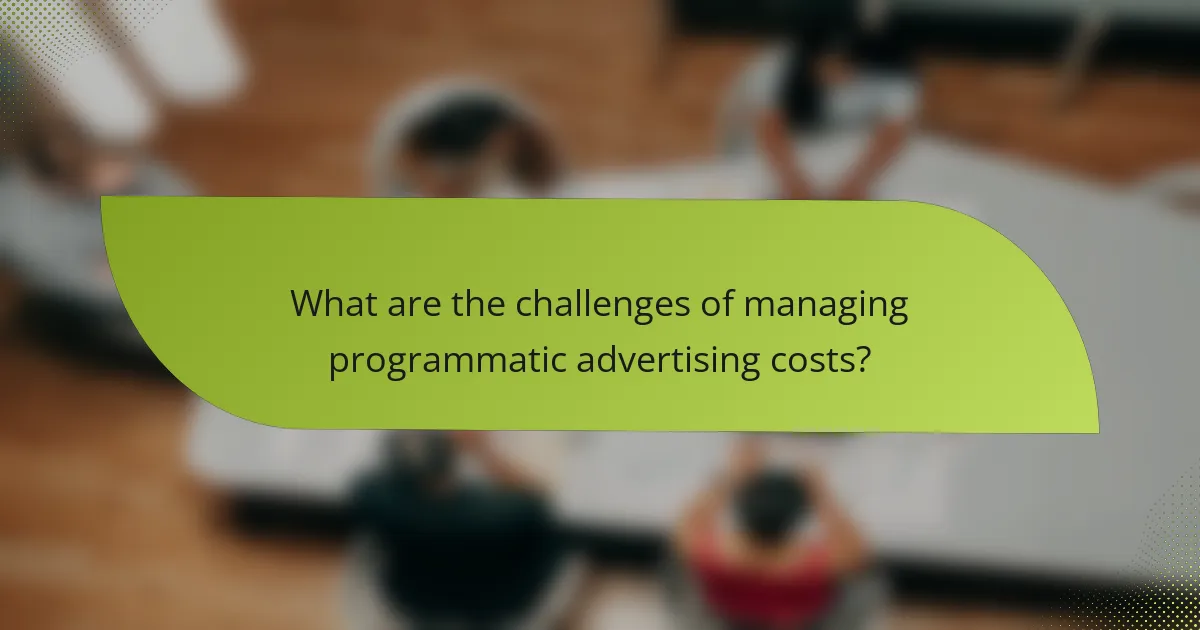
What are the challenges of managing programmatic advertising costs?
Managing programmatic advertising costs involves navigating various challenges that can lead to unexpected expenses. Key issues include budget overruns and ad fraud risks, both of which can significantly impact the overall effectiveness and profitability of advertising campaigns.
Budget overruns
Budget overruns occur when actual spending exceeds the planned budget for programmatic advertising. This can happen due to factors like increased competition for ad placements or unexpected spikes in demand for certain audiences. Advertisers should set clear budget limits and monitor spending closely to avoid these pitfalls.
To manage budget overruns effectively, consider implementing daily or weekly spending caps. Regularly reviewing campaign performance can also help identify areas where adjustments are needed to stay within budget. Utilizing tools that provide real-time analytics can enhance oversight and control.
Ad fraud risks
Ad fraud risks refer to deceptive practices that can lead to wasted ad spend, such as click fraud or impression fraud. These fraudulent activities can inflate metrics and mislead advertisers about the effectiveness of their campaigns. Understanding these risks is crucial for maintaining a healthy advertising budget.
To mitigate ad fraud, advertisers should invest in fraud detection tools and work with reputable ad networks that prioritize transparency. Regular audits of campaign performance metrics can also help identify suspicious activity. Implementing verification measures can safeguard against fraudulent impressions and clicks, ensuring that advertising dollars are spent effectively.
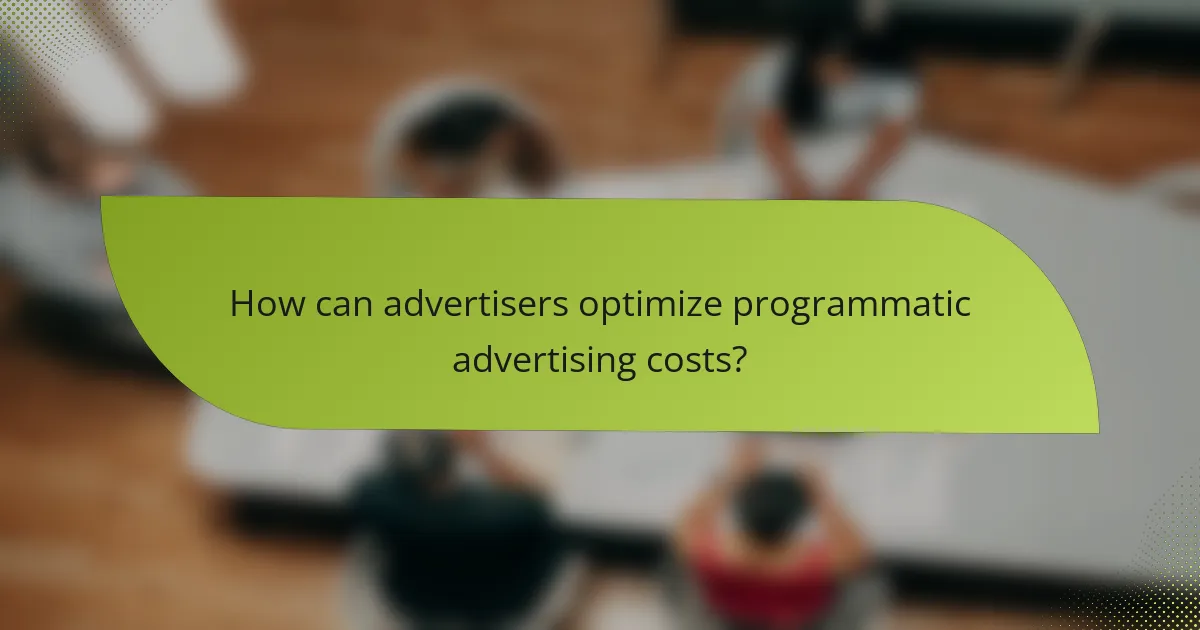
How can advertisers optimize programmatic advertising costs?
Advertisers can optimize programmatic advertising costs by focusing on targeting strategies, bidding techniques, and data analysis. Effective management of these elements can lead to better ad placements and improved return on investment (ROI).
Understanding the Cost Structure
The cost structure of programmatic advertising typically includes several components such as CPM (cost per mille), CPC (cost per click), and CPA (cost per acquisition). Advertisers should familiarize themselves with these metrics to assess the effectiveness of their campaigns. Understanding how each component contributes to overall expenses can help in making informed decisions.
For example, CPM is often used for brand awareness campaigns, while CPC is more suitable for performance-driven goals. Advertisers should analyze their objectives to choose the right pricing model.
Leveraging Data and Analytics
Data plays a crucial role in optimizing programmatic advertising costs. By utilizing analytics tools, advertisers can gain insights into audience behavior, ad performance, and bidding strategies. This information allows for better targeting and more efficient budget allocation.
Regularly reviewing campaign data helps identify underperforming ads or audiences, enabling advertisers to adjust their strategies promptly. A/B testing different creatives or targeting options can also yield valuable insights.
Implementing Targeting Strategies
Effective targeting strategies can significantly reduce wasted ad spend. Advertisers should consider using demographic, geographic, and behavioral targeting to reach the most relevant audiences. This precision helps ensure that ads are shown to users who are more likely to engage.
For instance, using retargeting can help re-engage users who have previously interacted with the brand, often leading to higher conversion rates. Advertisers should continuously refine their targeting based on performance metrics.
Choosing the Right Bidding Strategy
Selecting an appropriate bidding strategy is essential for optimizing costs. Advertisers can choose between automated bidding, which adjusts bids based on performance, or manual bidding, which allows for more control. Each method has its advantages and trade-offs.
For example, automated bidding can save time and optimize for conversions, while manual bidding may be better for campaigns with specific budget constraints. Testing different strategies can help identify the most effective approach for each campaign.
